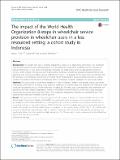| dc.contributor.author | Toro, Maria L | |
| dc.contributor.author | Pearlman, Jonathan | |
| dc.contributor.author | Eke, Chika Uzoma | |
| dc.date.accessioned | 2016-01-25T17:09:45Z | |
| dc.date.available | 2016-01-25T17:09:45Z | |
| dc.date.issued | 2016-01 | |
| dc.date.submitted | 2014-11 | |
| dc.identifier.issn | 1472-6963 | |
| dc.identifier.uri | http://hdl.handle.net/1721.1/100977 | |
| dc.description.abstract | Background
For people who have a mobility impairment, access to an appropriate wheelchair is an important step towards social inclusion and participation. The World Health Organization Guidelines for the Provision of Manual Wheelchairs in Less Resourced Settings emphasize the eight critical steps for appropriate wheelchair services, which include: referral, assessment, prescription, funding and ordering, product preparation,fitting and adjusting, user training, and follow-up and maintenance/repairs. The purpose of this study was to investigate how the provision of wheelchairs according to the World Health Organization’s service provision process by United Cerebral Palsy Wheels for Humanity in Indonesia affects wheelchair recipients compared to wait-listed controls.
Methods
This study used a convenience sample (N = 344) of Children, Children with proxies, Adults, and Adults with proxies who were on a waiting list to receive a wheelchair as well as those who received one. Interviews were conducted at baseline and a 6 month follow-up to collect the following data: Demographics and wheelchair use questions, the World Health Organization Quality of Life-BREF, Functional Mobility Assessment, Craig Handicap Assessment Recording Technique Short Form. The Wheelchair Assessment Checklist and Wheelchair Skills Test Questionnaire were administered at follow up only.
Results
167 participants were on the waiting list and 142 received a wheelchair. Physical health domain in the World Health Organization Quality of Life-BREF improved significantly for women who received a wheelchair (p = 0.044) and environmental health improved significantly for women and men who received a wheelchair as compared to those on the waiting list (p < 0.017). Satisfaction with the mobility device improved significantly for Adults with proxies and Children with proxies as compared to the waiting list (p < 0.022). Only 11 % of Adults who received a wheelchair reported being able to perform a “wheelie”. The condition of Roughrider wheelchairs was significantly better than the condition of kids wheelchairs for Children with proxies as measured by the Wheelchair Assessment Checklist (p = 0.019).
Conclusions
Wheelchair provision according to World Health Organization’s 8-Steps in a less-resourced setting has a range of positive outcomes including increased satisfaction with the mobility device and better quality of life. Wheelchair provision service could be improved by providing more hours of wheelchair skills training. There is a need for outcome measures that are validated across cultures and languages. | en_US |
| dc.description.sponsorship | United States. Agency for International Development (Grant GPO-A-00-04-00021-00 SPANS 001) | en_US |
| dc.description.sponsorship | National Science Foundation (U.S.) (ASPIRE Grant 1262670) | en_US |
| dc.description.sponsorship | United States. Veterans Administration (Grant B6789C) | en_US |
| dc.publisher | BioMed Central | en_US |
| dc.relation.isversionof | http://dx.doi.org/10.1186/s12913-016-1268-y | en_US |
| dc.rights | Creative Commons Attribution 4.0 International License | en_US |
| dc.rights.uri | http://creativecommons.org/licenses/by/4.0/ | en_US |
| dc.source | BMC | en_US |
| dc.title | The impact of the World Health Organization 8-steps in wheelchair service provision in wheelchair users in a less resourced setting: a cohort study in Indonesia | en_US |
| dc.type | Article | en_US |
| dc.identifier.citation | Toro, Maria L., Chika Eke, and Jonathan Pearlman. “The Impact of the World Health Organization 8-Steps in Wheelchair Service Provision in Wheelchair Users in a Less Resourced Setting: a Cohort Study in Indonesia.” BMC Health Serv Res 16, no. 1 (December 2015). | en_US |
| dc.contributor.department | Massachusetts Institute of Technology. Department of Mechanical Engineering | en_US |
| dc.contributor.mitauthor | Eke, Chika Uzoma | en_US |
| dc.relation.journal | BMC Health Services Research | en_US |
| dc.eprint.version | Final published version | en_US |
| dc.type.uri | http://purl.org/eprint/type/JournalArticle | en_US |
| eprint.status | http://purl.org/eprint/status/PeerReviewed | en_US |
| dc.date.updated | 2016-01-23T05:39:39Z | |
| dc.language.rfc3066 | en | |
| dc.rights.holder | Toro et al. | |
| dspace.orderedauthors | Toro, Maria L.; Eke, Chika; Pearlman, Jonathan | en_US |
| dc.identifier.orcid | https://orcid.org/0000-0002-7723-8311 | |
| mit.license | OPEN_ACCESS_POLICY | en_US |
